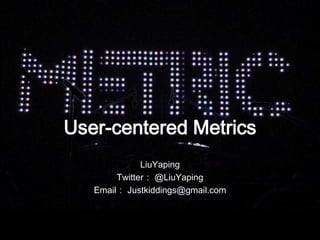User centered metics
- 1. User-centered MetricsLiuYapingTwitter: @LiuYapingEmail: Justkiddings@gmail.com
- 2. AgendaWho am I? (5mins) User-centered metrics(45mins)Affinity diagram brainstorming(45mins)Q&A(15mins)
- 3. 对于我
- 5. D A T AData is power!
- 7. User-centered metrics常用的产物数据P = page views U = uptime L = latency S = seven day active users E = earnings
- 10. 明确 – 不会引入无关的噪音敏感 – 会根据结果对应的变化清楚 - 能被听众准确的理解大众 – 会被广泛使用
- 13. H.E.A.R.TH = happiness E = engagementA = adoption R = retentionT = task success
- 16. Happiness
- 17. Happiness
- 18. Engagement: 频率 / 深度 / 广度
- 19. User-centered metrics Adoption and retention
- 20. Task success
- 23. User-centered metrics Goal Signal? Metrics Implement小范围讨论UX, PM头脑风暴ENG, PM, UX实现PM, ENG
- 24. Goal
- 25. Signals
- 26. Metrics
- 27. Implementation
- 32. Brainstorming
- 33. Grouping
- 34. Prioritizing
- 35. Enhancing
- 36. Thanks
Editor's Notes
- #3: 用户体验的数据衡量体系相关图表法设计工作坊
- #4: 介绍结束后请提问
- #10: 我家挺小的,才两居室…前几天高烧到102贵…北京很冷啊,得穿厚一点的外套…
- #12: User-centered metrics are measurements of key aspects of product performance from the perspectives of the users.page view 是不是可以很好的衡量用户体验?7day active users 是不是可以很好的衡量用户体验?
- #14: H = happiness -用户的主观态度是什么? E = engagement – 用户 A = adoption - at what rate are new users of the product being acquired? R = retention – 黏性 T = task success – 用户是否能够成功的完成任务?是不是足够高效?
- #16: 1, 内部工具 vs第三方调研2, 抱怨的少数vs沉默的大多数3, 自己 vs竞争对手
- #18: 拆分成细的方面
- #19: Among these dimensions of engagement:Frequency: how often the user visits GmailIntensity: amount of activity during a visit (e.g. events)Depth: usage of key features (e.g. sending mail)更多维度: 在淘宝上花的钱 / 在QQ上发的消息数
- #21: 不仅仅是完成,还需要效率和速度
- #22: Happiness 整体易用度 对照片上传工具的满意度Engagement 每个用户每天的PV 每周分享多少张照片Adoption 新用户的增长率 创建新相册的用户增长率Retention 老用户的流失率 查看收藏夹内容的用户增长率Task Success 多少用户点了搜索结果 注册流程完成率
- #25: 考虑产物的价值,而不是愿景。 Decision making engine for Bing / organize information for Google / 考虑不同USE CASES考虑产物不同阶段考虑产物的长短期目标细化到具体feature
- #26: 不要讨论如何改善/实现事情有两面,对于失败的指标 有时候更容易被测量到长短期的目标 结合和平衡
- #33: 1, ? background information sharing2, 6 participants, each participant generate 3 ideas within 3 minutes. 3, passing around, Rotate idea sheet every 3 minutes, until the original idea sheet get back to the starter. 4, generate new ideas based on others
- #34: sort a large number of ideas, process variables, concepts, and opinions into naturally related groups.describe ideas with phrases or sentences. Aim for 5-10 groups. If one group is much larger than others, consider splitting it.? Minimize the discussion while sorting -- discuss while developing the header cards. Ultimately reach agreement on placement, if for no other reason than exhaustion.
- #35: Prioritizatization Matrix. To prioritize sorted groups require deep understanding on problem situation. Dimensions:What is your favorite? difficulty of implementation value to company value to users long term or short team goal a couple of real use cases that need to be supported
- #36: Focused on the selected group. Enhance it with more ideas. And pick
- #37: Focused on the selected group. Enhance it with more ideas. And pick



































